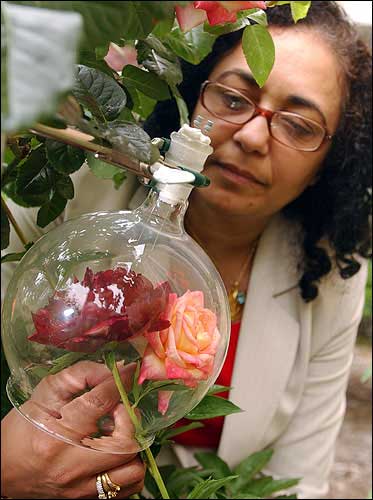Living flower technology makes rose perfume actually smell like a rose
Union Beach, N.J. ? A Garden of Eden for perfumers is in a most unlikely place.
Inside a rather nondescript building in a rather nondescript industrial office park about an hour outside of New York City lies the laboratory of the International Flavors & Fragrances Inc.
The name isn’t sexy, and the scientists and technicians wearing white coats and goggles don’t suggest that this place is aon the cutting edge of the beauty industry. But it is.
IFF developed a technology that captures the scent of living flowers, which Subha Patel, who oversees the company’s greenhouse, will tell you is entirely different than the extracts, essential oils or ground petals that are most familiar to perfume wearers.
A living flower has a freshness and a complexity that dead plant material just can’t compete with, Patel says.
“The difference between a rose absolute (extract) and a living rose flower can be black and white,” explains Patel, an associate research fellow in natural products and exploratory research who leads the team that develops novel molecules for flavors and fragrances. “When you extract molecules from a flower for a fragrance, you pull all the molecules out. That might not smell like the flower, which wasn’t expressing all the molecules at once.”
A rose also will smell differently if it is grown hydroponically, living in a pool of water grounded by pebbles, or in a garden near vegetables and herbs.
“Each flower has a biorhythm, a life cycle. A perfumer may or may not want the ‘peak’ scent. There are many different accords from the same single flower,” Patel says.
Orchids and newborns
To capture the fragrance of live flowers, a glass globe is placed over a blooming bud with a retractable needle positioned as close to the flower as possible without touching it. The scented atmosphere immediately surrounding a flower is called “headspace.”

Subha Patel, director of botanical fragrance technology at International Flavors & Fragrances Inc., places a glass globe over two flowers to collect their combined fragrance molecules at an IFF greenhouse in Union Beach, N.J. The fragrance is collected for about 30 minutes then analyzed in a computer to re-create the flower aroma for use in perfumes.
The molecules emitted from the flower at that moment bind to the tip, Patel says. It takes 30 minutes to get an accurate reading, then the results are fed into a computer that creates a fragrance profile.
From there, the fragrance can be re-created again and again and again.
“We’re producing nature-identical molecules, produced synthetically,” explains Clint Brooks, IFF senior vice president of research and development.
OK, so what does that mean to a typical perfume-wearing woman?
It means she can now smell like an orchid that only blooms at night, or the trees found on the beach of a remote Pacific island, or kaffir lime.
And the smells that Living Flower Technology captures and re-creates aren’t limited to flowers: IFF produced Gigabyte, a perfume based on the smell of computers as a special project for Visionaire magazine.
Instead of the needle collecting a flower’s molecules, it captured the headspace in the Apple computer store in Manhattan’s SoHo neighborhood, Patel says. Other nontraditional fragrances have been based on bread, cooked rice and a newborn baby.
Most perfumers are coming to IFF asking “What’s new? What’s unique?” — a response to fashion-conscious consumers who are always looking for the next big thing, Patel says.
Right now, Patel would encourage using basil, or natural curry, which looks like rosemary and has a sweet scent.
“We’re also getting a lot of requests for the flowers of fruit,” she reports.
Ideal investment
The Living Flower technique is cost-effective for perfumers because there are no limits based on growing season, location, weather or rarity, Patel notes, since all it takes is a single plant that is kept in an ideal environment controlled by thermometers, computers and automatic sprinklers. “There is never a drought or an early frost in our greenhouse,” she says.
Patel also has overseen the development of a technology called Romance of Flowers, which allows the “emotions” of two different flowers to be blended into a single smell. “It’s a marriage,” she explains. “When flowers sense each other, their profiles change.”
The ability to create scent profiles from headspace has opened up many new avenues in the fragrance industry because perfumers now have new base ingredients to work with, Brooks says. “The possibilities really are endless,” he says.
Patel points out that all these fragrance-development techniques are environmentally friendly since no chemicals are used to treat the plants and the plants remain undisturbed throughout the entire process.

